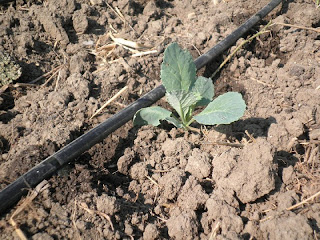WATERMELON (F/P) One last week of melons. The scorching heat did a number on the last planting, but we found enough to get everyone a red or yellow one.
TOMATOES (F/P) Another 3 or 4, but also some romas or cherry tomatoes thrown in.
POTATOES (F/P)
RED AND WHITE ONIONS (F/P) One of each
SUMMER SQUASH (F) There will be a few warty yellow ones in the mix,
Rugosa Friulana from the region near Venice, Italy. It’s a bit ugly, but has good flavor with no squeaky texture.
SWEET PEPPERS OR OKRA (F/P) See Tom’s post for the best okra recipe ever (no slime!) submitted by of your fellow CSA members.
EGGPLANT (F) I know it is not a familiar vegetable to alot of my fellow Midwesterners, but it grows well in our region. There are more recipes for eggplant than any other vegetable, many of which are quite delicious.
SALSA PACK/PEPPERS (F) The tomatillos are slowing down, so some will get another shot at sweet peppers instead of the salsa.
HERB CHOICE: Basil, thyme or a dried herb.
ALSO THIS WEEK: Bread of Life Bakery delivery
NEXT WEEK: more tomatoes, peppers, eggplant, okra and squash. Cucumbers, green beans, carrots and garlic return.
The big break in the weather this past weekend signaled our entrance into late summer. The final plantings of cucumbers, tomatoes, beans and squash will be on the plate for another few weeks. The peppers, eggplant and okra have been growing since early spring, but have one last push through the month of September before falling to frost. These summer fruits will continue to be combined with the storage crops of potatoes, onions, carrots and garlic safely kept in the upper barn.

our newest addition to the stores
Winter squash has recently joined its fellow keepers in the barn. After we harvested the standard issue of tomatoes, squash, cukes, peppers, eggplant, okra and tomatillos in preparation for tomorrow’s shares, the rest of today was spent harvesting a lovely crop of butternut, acorn squash and pie pumpkins.
Our relationship with winter squash is a tumultous one. We love them as they are tasty and keep far into the winter. All too often, however, we have been left at the end of fall with no crop. Vine borers, squash bugs and cucumber beetles along with various viruses, mildews and wilts are formidable opponents for an organic farmer armed with row cover and not much else. This year a combination of technique and luck seems to have paid off. We added generous amounts of Missouri Organic compost and used the Allis-Chalmers G to make hills. The weather was pretty ideal during most of their growth -warm and relatively dry. So, who knows what made the difference and really, in the end, who cares! We’ve got lots of winter squash to eat! But not yet, in a couple weeks. We’ll put them in the share when they are fully cured and when a warm butternut squash soup sounds just right.











